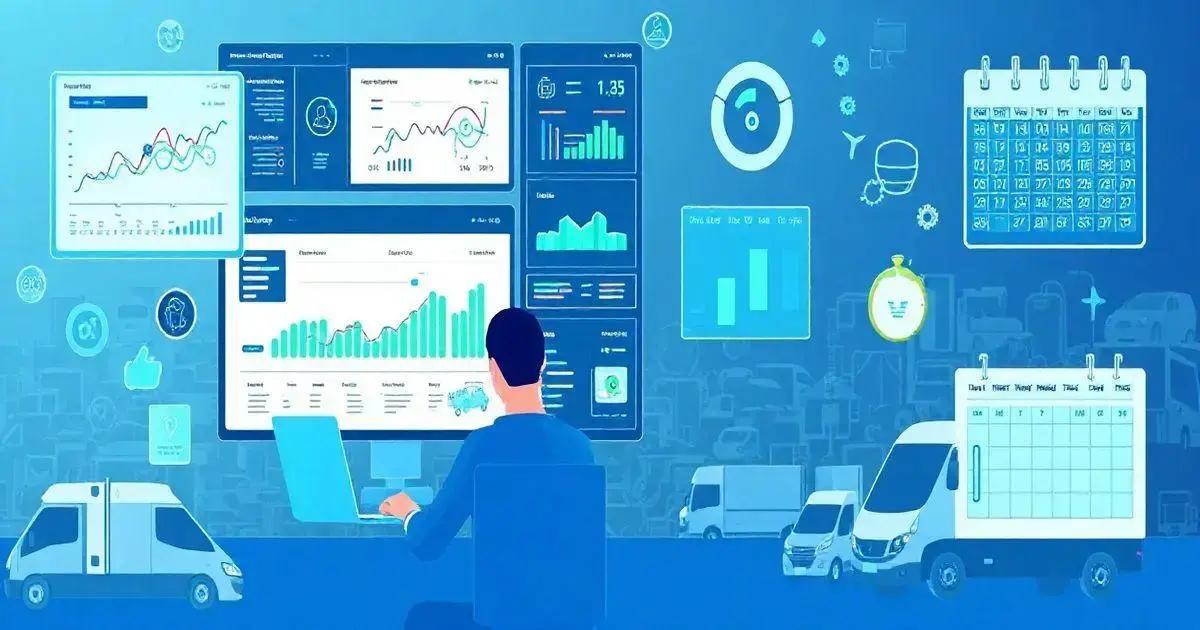Top 5 Features of Fleet Control Worksheet 7.0 You Need Leave a comment
The Fleet Control Worksheet 7.0 is a management tool that optimizes fleet operations by providing dashboards for performance metrics, tracking travel and cargo, managing tire usage, organizing maintenance schedules, and centralizing document management, ultimately enhancing decision-making and compliance while reducing costs and improving vehicle safety.
The Fleet Control Worksheet 7.0 is an innovative tool designed to help businesses manage their fleet efficiently. With an array of features, it simplifies tasks such as travel control, maintenance tracking, and overall fleet management, ensuring you can focus on what really matters—growing your business. In this article, we’ll dive into the top five features that make this worksheet a must-have for fleet managers.
Initial Dashboards Overview
The Fleet Control Worksheet 7.0 features comprehensive initial dashboards that provide vital insights into your fleet’s performance. These dashboards are designed to help fleet managers quickly assess key metrics, ensuring informed decision-making at a glance.
Here’s a breakdown of the primary components you can expect:
- KM by Driver: Track the kilometers driven by each driver, allowing you to analyze driving patterns and efficiency.
- KM per Vehicle: Evaluate the distance each vehicle travels, helping you identify underutilized assets.
- KM per Liter: Monitor fuel efficiency across your fleet, crucial for managing fuel costs and overall environmental impact.
- KM per Trip: Understand the distance per trip, which aids in planning and optimizing routes.
- Average Consumption per Vehicle: Assess fuel consumption on a per-vehicle basis, illuminating which vehicles may need maintenance or a review of driving habits.
- Average Consumption per Driver: Compare drivers to identify high and low fuel consumption, encouraging efficient driving practices.
- Total General Maintenance: Keep track of all maintenance activities, both preventive and corrective, ensuring that your vehicles remain in top condition.
- Maintenance Cost Average: Analyze maintenance costs over time to budget effectively and identify trends.
- Total Mechanical and Electrical Maintenance Costs: Gain insights into the costs associated with mechanical and electrical issues, allowing you to allocate resources appropriately.
- Total Tire Maintenance Cost: Review expenses related to tire maintenance to understand how it impacts your overall fleet costs.
- Total Lubricant Cost: Track lubricant expenses to ensure you are adhering to maintenance schedules and avoiding unnecessary costs.
- Average Maintenance Costs: Evaluate average costs across your fleet to find ways to reduce expenses.
- Delayed Vehicle Documents: Keep an eye on vehicle documentation that is overdue, helping to maintain compliance.
- Vehicles in Transit: Monitor vehicles currently on the road, providing real-time status for better logistics management.
These dashboards are not only user-friendly but also provide actionable insights that can significantly enhance the operational efficiency of your fleet. By leveraging this data, fleet managers can make proactive decisions that drive performance and reduce costs.

Travel and Cargo Control Features
The Fleet Control Worksheet 7.0 excels in managing travel and cargo logistics, providing essential tools that keep your operations smooth and efficient. These features are tailored to assist fleet managers in overseeing every aspect of transportation, ensuring that cargo is handled properly and delivered on time.
Here’s a look at the key functionalities you can leverage:
Travel and Cargo Control Features
- Cargo Control Linked to Trips: This feature allows for direct tracking of cargo associated with specific trips. By linking cargo details with travel plans, managers can ensure that all items are accounted for and properly documented.
- Vehicle Control: Monitor vehicle assignments for each trip, ensuring that the right vehicle is matched with the required cargo. This aids in optimizing fleet utilization and reducing unnecessary costs.
- Driver Control: Keep records of which drivers are assigned to which trips. This feature helps in analyzing driver performance and accountability, which is crucial for maintaining standards and improving service quality.
- Supply Control: Track the supplies required for each trip, ensuring that all necessary items are loaded beforehand. This minimizes delays caused by missing supplies and enhances overall trip efficiency.
- Control of All Travel Expenses: Maintain a comprehensive overview of all expenses incurred during travel, including fuel, tolls, and other costs. This feature enables managers to effectively budget and assess the financial impact of their operations.
Utilizing these travel and cargo control features, fleet managers can significantly reduce errors, improve efficiency, and enhance the reliability of their logistics operations. The clarity provided by this comprehensive control over travel logistics allows for informed decision-making that can lead to cost savings and better service delivery.
Tire Control Management
The Fleet Control Worksheet 7.0 includes a robust Tire Control Management feature designed to facilitate the effective oversight of tire usage and maintenance. Proper tire management is crucial for ensuring the safety, efficiency, and longevity of your fleet vehicles.
Here’s what this feature encompasses:
Tire Control Management
- Identification for Each Tire: Keep detailed records of each tire on your fleet, including brand, size, and identification numbers. This helps in tracking usage and ensures that you have the right tires for each vehicle.
- Tire Change Schedule by KM: Set up reminders for tire changes based on kilometers driven. This proactive approach helps prevent tire wear and tear, enhancing safety and reducing the risk of blowouts.
- Remaining KM Until Tire Change: Monitor and receive alerts on how many kilometers are left before tires need to be changed. This predictive maintenance helps in planning repairs and replacements ahead of time.
- Status per Action: Manage the status of each tire with options like allocate to vehicle, remove from vehicle, scrap, or maintenance. This flexibility allows for quick adjustments based on operational needs.
By implementing effective Tire Control Management, fleet managers can ensure that tires are maintained in optimal condition, which not only enhances safety but also improves fuel efficiency and reduces overall costs associated with tire replacements and repairs.

Preventive and Corrective Maintenance
The Fleet Control Worksheet 7.0 features comprehensive tools for managing both preventive and corrective maintenance, crucial elements for keeping your fleet in top working condition. Effective maintenance scheduling minimizes downtime and extends the lifespan of your vehicles.
Here’s an overview of the key components included in this maintenance management feature:
Preventive and Corrective Maintenance
- Maintenance Type Tracking: Easily categorize maintenance tasks into preventive and corrective types. Preventive maintenance involves routine checks and services designed to prevent breakdowns, while corrective maintenance addresses issues that occur during vehicle operation.
- Maintenance by Vehicle: Keep detailed logs of maintenance activities for each vehicle in your fleet. This allows managers to track service history, identify trends, and schedule future maintenance effectively.
- Maintenance by Category: Manage maintenance tasks according to mechanical and electrical types, tires, and lubricants. This categorization ensures that every aspect of vehicle maintenance is covered and prioritized appropriately.
- Maintenance Cost Monitoring: Analyze costs associated with maintenance activities to identify areas where improvements can be made. Understanding these expenses helps in budgeting and can lead to cost-saving opportunities.
- Preventive Maintenance Schedule: Set up a calendar for scheduled preventive maintenance tasks. This proactive approach ensures that vehicles receive regular servicing, reducing the likelihood of unexpected breakdowns.
- Maintenance Status Updates: Easily update the status of maintenance tasks to indicate whether they are scheduled, accomplished, or delayed. This feature aids in maintaining clear communication among team members and keeps everyone informed about vehicle health.
By leveraging the Preventive and Corrective Maintenance features of the Fleet Control Worksheet 7.0, fleet managers can optimize vehicle performance, enhance safety, and significantly reduce unforeseen repair costs. This proactive maintenance approach not only ensures reliability but also contributes to overall operational efficiency.
Document Management Functions
The Fleet Control Worksheet 7.0 comes equipped with essential Document Management Functions that streamline the handling of vital documents related to your fleet operations. Effective document management is key to ensuring compliance, efficiency, and easy access to necessary information.
This feature includes several important capabilities:
- Driver Document Control: Maintain comprehensive records of all driver-related documents, including licenses, certifications, and training records. This ensures that all necessary documentation is up to date and easily accessible.
- Vehicle Document Control: Manage the documentation for each vehicle in your fleet, such as registration, insurance, and inspection certificates. This centralized approach helps in keeping track of critical compliance documents and alerts managers of any pending renewals.
By implementing efficient Document Management Functions, fleet managers can reduce the risk of compliance issues and ensure that all necessary paperwork is readily available for audits and inspections. This not only enhances operational efficiency but also contributes to the overall safety and legality of your fleet operations.
Conclusion
The Fleet Control Worksheet 7.0 is an invaluable tool for fleet managers, offering a comprehensive suite of features designed to optimize fleet management and enhance operational efficiency.
From initial dashboards that provide key performance insights to robust document management functions, every aspect of fleet oversight is covered.
By utilizing the travel and cargo control features, tire control management, and maintenance tracking, you can ensure that your fleet operates smoothly and stays compliant with all regulations.
Proactive maintenance and effective document management not only save time but also reduce operational costs and improve safety.
In today’s competitive environment, having the right tools at your disposal is crucial.
The Fleet Control Worksheet 7.0 equips you with everything you need to make informed decisions and drive your fleet’s success.
Embrace this powerful solution and take your fleet management to the next level!
FAQ – Frequently Asked Questions about Fleet Control Worksheet 7.0
What features does the Fleet Control Worksheet 7.0 offer?
The Fleet Control Worksheet 7.0 offers features such as initial dashboards, travel and cargo control, tire control management, preventive and corrective maintenance tracking, and document management functions.
How can I track tire maintenance with the worksheet?
You can track tire maintenance by using features that allow you to schedule tire changes, monitor tire usage, and maintain records for each tire, including their condition and service history.
Is the worksheet user-friendly for fleet managers?
Yes, the Fleet Control Worksheet 7.0 is designed to be user-friendly, with intuitive layouts and easy navigation to help fleet managers quickly access and manage their data.
Can I customize the maintenance schedules for my fleet?
Absolutely! The worksheet allows you to set up customized preventive maintenance schedules based on kilometers driven or specific time intervals.
What type of documents can I manage with this worksheet?
You can manage a variety of documents including driver licenses, vehicle registrations, insurance papers, and maintenance records, all centralized for easy access.
Is there customer support available for the Fleet Control Worksheet 7.0?
Yes, customer support is available to assist with any questions or technical issues you may encounter while using the Fleet Control Worksheet 7.0.

